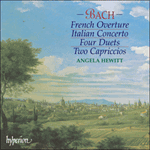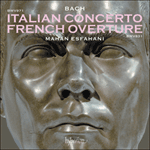The
Capriccio in B flat major ‘on the departure of his beloved brother’, BWV992, was always thought to have been written in honour of another older brother, the oboist Johann Jakob, who went off in 1704 to join the band of the Swedish king, Charles XII. Christoph Wolff, in his book
Johann Sebastian Bach: The Learned Musician (New York, 2000), puts forward the theory that for various reasons the farewell was more likely for a friend, no doubt Georg Erdmann, with whom he set out for Lüneburg. This would bring the date forward by two years to when Bach was seventeen years old. It is his only piece of programme music (one with a specific story attached to it), and shows an already imaginative and skilled composer. The six movements outline the story: in the first a tender, supplicating melody paints a picture of his friends trying to dissuade him from leaving. In perhaps the least inspired musical moment of the piece (a short fugue), they then warn him of misfortunes that could arise on his journey. Having failed in their efforts, his imminent departure is then lamented. Marked Adagissimo, this movement is in the form of a passacaglia and requires the interpreter to fill in a figured bass. The key of F minor is prophetic: he would later use it for some of his most sorrowful, expressive music. The fourth movement (where some embellishment is also surely required at the beginning) shows the friends giving in to what is inevitable, and saying goodbye. Then the postal coach arrives, blowing its horn (translated into music by a downward octave leap). The piece then ends with a fugue combining two motives: the subject suggesting trumpets, and the countersubject imitating the posthorn. Hubert Parry called this
Capriccio ‘the most dexterous piece of work of the kind that had ever appeared in the world up to that time’. It is certainly unique in Bach’s output.
from notes by Angela Hewitt © 2001
Selon une tradition bien établie, le
Capriccio sopra la lontananza del suo fratello dilettissimo («Caprice sur le départ de son frère bien-aimé»), BWV992, aurait été composé en l’honneur d’un autre frère aîné, le hautboïste Johann Jakob qui partit en 1704 rejoindre l’harmonie du roi de Suède, Charles XII. Dans son ouvrage
Johann Sebastian Bach: The Learned Musician (New York, 2000), Christoph Wolff avance l’hypothèse que, pour diverses raisons, les adieux étaient plus probablement destinés à un ami, Georg Erdmann sans aucun doute, avec lequel il partit pour Lüneburg. La date de composition serait alors avancée de deux ans. Seule musique à programme (soit attachée à une histoire spécifique) de l’ample catalogue bachien, cette œuvre illustre à quel point le jeune compositeur de dix-sept ans était déjà doué d’une imagination vivide et d’un talent immense. Les six mouvements soulignent les éléments du récit: dans le premier, une mélodie tendre et suppliante dresse le portrait de ses amis essayant de le détourner de ce voyage. Au cours du passage peut-être le moins inspiré de l’œuvre (une courte fugue), ils le mettent en garde contre les divers accidents qui peuvent lui arriver dans les pays étrangers. N’étant pas parvenu à le dissuader, ils entonnent une lamentation sur son départ imminent. Noté Adagissimo ce mouvement est élaboré sous la forme d’une passacaille et requiert la réalisation de la basse chiffrée. La tonalité de fa mineur est par ailleurs prophétique puisqu’il l’utilisera plus tard dans une partie de sa musique la plus expressive et poignante. Le quatrième mouvement (dont le début appelle sûrement quelques ornementations) dépeint ses amis qui se résignent à le voir partir et viennent lui dire adieu. Puis le postillon arrive, faisant entendre son cor (traduit musicalement par les sauts descendants d’une octave). La pièce se conclut par une fugue associant les deux motifs: le sujet suggère les fanfares de trompettes et le contre-sujet imite le son du postillon. Hubert Parry décrit ce Capriccio comme «la pièce la plus habile et virtuose du genre que le monde ait jamais vu à cette époque là». Il s’agit certainement d’une œuvre unique dans la production de Bach.
extrait des notes rédigées par Angela Hewitt © 2001
Français: Isabelle Battioni
Vom
Capriccio auf die Abreise eines geliebten Bruders („sopra la lontananza del suo fratello dilettissimo“), BWV992, wurde stets vermutet, es sei zu Ehren eines anderen älteren Bruders verfaßt worden, nämlich des Oboisten Johann Jakob Bach, der 1704 auszog, um der Kapelle des Schwedenkönigs Karl XII. beizutreten. Christoph Wolff vertritt in seinem Buch
Johann Sebastian Bach: The Learned Musician (New York 2000; dt. „Johann Sebastian Bach“, Frankfurt/M. 2000) die These, daß der Abschied aus verschiedenen Gründen eher einem Freund gegolten haben könnte, höchstwahrscheinlich Georg Erdmann, mit dem Bach nach Lüneburg gegangen war. Damit würde das Kompositionsdatum um zwei Jahre vorverlegt, auf die Zeit, als Bach siebzehn Jahre alt war. Es ist sein einziges Stück Programmusik (d.h. mit einer bestimmten Textvorlage verbunden) und zeigt einen bereits einfallsreichen und gewandten Komponisten. Die sechs Sätze umreißen die Geschichte: Im ersten zeichnet eine zärtliche, flehentliche Melodie ein Bild davon, wie die Freunde ihn von seiner Reise abzuhalten versuchen. Im wohl am wenigsten gelungenen Moment des Stücks (einer kurzen Fuge) warnen sie ihn vor den Mißgeschicken, die ihm auf seiner Reise begegnen könnten. Nachdem sie mit ihren Bemühungen gescheitert sind, wird seine bevorstehende Abreise beklagt. Der Adagissimo bezeichnete Satz ist als Passacaglia gestaltet und verlangt vom Interpreten, einen bezifferten Baß auszusetzen. Die Tonart f-Moll ist prophetisch: Bach sollte sie später in seiner leidvollsten, ausdrucksstärksten Musik zum Einsatz bringen. Der vierte Satz (in dem sicherlich zu Beginn ebenfalls einige Auszierung nötig ist) stellt die Freunde dar, wie sie sich dem Unvermeidlichen fügen und Lebewohl sagen. Dann trifft die Postkutsche ein (der Klang des Posthorns wird durch einen Oktavsprung abwärts dargestellt). Das Stück endet mit einer Fuge, die zwei Motive verbindet: Das Subjekt deutet Trompeten an, das Kontrasubjekt ahmt das Posthorn nach. Hubert Parry nannte dieses Capriccio „das geschickteste Werk seiner Art, das die Welt bis dahin gekannt hatte“. In Bachs Schaffen ist es jedenfalls einzigartig.
aus dem Begleittext von Angela Hewitt © 2001
Deutsch: Anne Steeb/Bernd Müller


 Bach: Angela Hewitt – The Bach Recordings
Bach: Angela Hewitt – The Bach Recordings Bach: Angela Hewitt plays Bach
Bach: Angela Hewitt plays Bach Bach: Italian Concerto & French Overture
Bach: Italian Concerto & French Overture Bach: Italian Concerto & French Overture
Bach: Italian Concerto & French Overture
